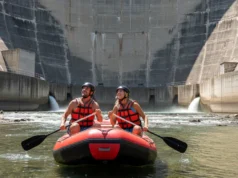In this article
Your raft gliding across a glassy, mirror-like pool, the silence broken only by the dip of your paddle. Ahead, the river constricts, and the placid surface erupts into a roaring, churning chaos of waves and whitewater characterized by irregular fluctuations. This transition between flow regimes isn’t random; it’s a physical language dictated by fluid properties and flow geometry. This guide is your Rosetta Stone, translating the principles of laminar and turbulent flow into the practical, on-the-water skill of reading the river’s current and navigating its power with instinct and precision.
Here, you will discover the two fundamental “personalities” of water: the orderly, predictable state of laminar flow and the chaotic, energetic state of turbulent fluid flow that defines all whitewater. We’ll uncover the transition point governed by the Reynolds number—the battle between inertia and viscosity that determines when a calm river turns into a churning rapid. Most importantly, you will learn how to identify the natural examples of turbulence—eddies, waves, holes, and tongues—and use them as a roadmap for navigating rapids. It’s time to translate this physical knowledge into a systematic approach for scouting and running whitewater, turning abstract science into confident action.
The Two States of Water: Laminar Calm and Turbulent Chaos
Every decision you make on the river is a response to the way water moves. At its core, that fluid motion boils down to two opposing states, or flow regimes. Understanding these foundational definitions—the core difference between laminar and turbulent flow—is the first step to seeing the river not as a single entity, but as a dynamic system of predictable flow behavior.
What Defines the Ideal, Orderly State of Laminar Flow?
Laminar flow, often called streamlined flow, is water in its most peaceful and organized state. It is characterized by fluid particles moving in smooth, predictable paths within parallel layers. You can visualize these smooth orderly layers as a deck of cards sliding over one another without shuffling; there is minimal mixing between them. This stable state is governed by viscosity, the fluid’s internal friction, which results in minimal frictional forces and low resistance. Common examples of laminar and turbulent flow include the slow, viscous drip of honey or the perfectly clear, glassy stream from a faucet turned on at a low velocity. In this regime, the velocity at any given point in the fluid remains steady and constant over time.
Because of its orderliness, laminar flow is highly efficient, with low energy dissipation. For a rafter, however, true, large-scale laminar flow is exceptionally rare. You might only observe it momentarily in very slow, deep, and perfectly unobstructed pools where the flow is laminar. It represents a baseline of perfect order—the state of tranquility from which the complex world of whitewater deviates. This academic understanding is supported by resources that explain the transition from laminar to turbulent flow, corroborating these foundational concepts. Linking this specific idea to the broader fundamental principles of river dynamics provides the macro context for why this matters on the water.
Pro-Tip: When you see that perfectly glassy, undisturbed surface on a river, it’s a reliable sign of deep, slow-moving water. This is your cue to relax, regroup, and prepare for the next section of river. But don’t get complacent; that calm often pools up right before a major constriction or gradient change.
If laminar flow is the river at rest, its opposite is the river alive with energy. This is the unstable state that commands our attention and respect.
Why is Turbulent Flow the Default State of a Whitewater River?
Turbulent flow is a flow regime defined by chaotic and irregular fluid motion. Instead of smooth streamlines, the flow is completely dominated by eddies—chaotic swirling patterns, cross-currents, and vortices of fluid of all sizes moving in random, unpredictable patterns. This state is characterized by increased mixing, high energy dissipation, and constantly fluctuating velocity and pressure. The noise, spray, and immense drag force of a rapid are the direct sensory manifestations of the increased energy dissipation occurring through this turbulence.
This constant churning is described by the “energy cascade,” where large eddies break down into smaller and smaller ones, until their energy is finally dissipated as heat by viscosity. This process dramatically increases drag and significant friction. For all practical purposes, turbulent flow is the default state of any moving river due to water’s low viscosity and the typically high velocity and scale of its movement, which guarantee a high Reynolds number. As a rafter, your entire challenge is not to fight turbulence, but to understand its structure and navigate the features it creates. You can find an in-depth, academic explanation of the Basics of Turbulent Flow in MIT course materials, which validates this description of eddies and energy dissipation.
The switch between these two states isn’t random; it’s a predictable event refereed by a single, crucial number.
The Tipping Point: What Turns Calm Water into Chaos?
The chaos of whitewater is actually predictable. The laminar-turbulent transition from a placid pool to a churning rapid is governed by a critical mechanism that acts like a switch, and understanding that switch is key to anticipating the river’s next move.
How Does the Reynolds Number Act as the River’s Referee?
The transition between flow states is governed by a dimensionless parameter called the Reynolds number (Re). It is best understood as the outcome of a battle between two opposing forces within the fluid. On one side are Inertial Forces (related to momentum convection), which are the fluid’s tendency to keep moving due to its mass and velocity. High inertial forces promote chaos. On the other side are Viscous Forces (related to momentum diffusion), which are the forces of internal friction that resist motion and smooth out disturbances. High viscous forces promote order.
The Reynolds number is calculated as the ratio of these inertial forces to viscous forces. High velocity, large scale (a factor related to the hydraulic diameter in engineering), and the density of the fluid all increase the inertial forces, pushing the number higher and favoring turbulence. Conversely, high viscosity acts as a brake, favoring laminar flow. Since water has a very low viscosity, it takes very little velocity to create a high Reynolds number, pushing it past the transition point. For pipe flow, this transition typically occurs around Re > 4000. In a river, the scale is so large and velocity so significant that the Reynolds number is almost always astronomically high, ensuring a turbulent state. For a clear, authoritative explanation, you can read the official definition of the Reynolds number from NASA. This physical principle is directly linked to the factors that form rapids, such as gradient and constriction, which increase velocity and turbulence.
| Laminar vs. Turbulent Flow | ||
|---|---|---|
| Characteristic | Laminar Flow | Turbulent Flow |
| Particle Path | Smooth, orderly, parallel layers (streamlines) | Chaotic, irregular, random, with mixing |
| Visual Appearance | Glassy, clear, smooth | Opaque, churning, white, foamy |
| Velocity | Constant at any given point; low overall velocity | Fluctuates constantly in magnitude and direction; high overall velocity |
| Dominant Force | Viscous Forces (internal friction) | Inertial Forces (momentum) |
| Reynolds Number | Low (typically < 2,300 in pipes) | High (typically > 4,000 in pipes) |
| Mixing | Minimal to none; layers slide past each other | High; characterized by eddies, swirls, and vortices |
| Energy Loss | Low; efficient for transport | High; energy dissipated as heat and sound |
| River Example | Very slow, deep, unobstructed pool or canal (rare) | Virtually all rapids and flowing river currents |
Now that we understand the ‘why’ behind turbulence, we can focus on the ‘what’—the specific, readable features this chaotic energy creates on the river’s surface.
Reading the River: How Do These Flows Create Whitewater Features?
This is where fluid dynamics becomes practice. The concept of turbulence is no longer abstract; it’s the engine that creates every identifiable and navigable feature in a rapid. Learning to see these features is learning to read the river’s language.
How Can You Read the “V’s” as the River’s Simplest Signals?
Amidst the complexity of a rapid, turbulence creates simple, reliable signals. The most fundamental of these are the “V’s” on the water’s surface.
The Downstream V (The Tongue) is the universal “go here” sign. It appears as a smooth, V-shaped chute of water with its point aimed downstream. This tongue is formed as the main current is funneled between two obstacles, like rocks or eddies. It marks the path of the deepest, fastest water, which often has a more uniform velocity profile, making it the primary target for navigation.
Conversely, The Upstream V is the corresponding “avoid this” sign. It appears as a V with its point aimed upstream. The obstacle itself—a submerged or partially submerged rock—is located at the apex of this V, with the “wings” of the V being the visible lines of flow diverging around the hazard, a clear sign of flow separation. Steering well clear of the point of an upstream V is a fundamental rule of safe river running. Learning to instantly differentiate these two signals is the first and most critical step to reading water. For a more detailed look, you can focus on mastering the Downstream V, the most important ‘go here’ signal on the water.
While the V’s provide the basic roadmap, the heart of river reading lies in understanding the specific features born from turbulence.
What Are Eddies and Why Are They a Rafter’s Safe Harbor?
An eddy is a zone of counter-current that forms in the low-pressure “shadow” immediately downstream of an obstruction that deflects the main flow direction. As the main current rushes past an obstacle, it leaves a void behind it. Water from downstream flows back upstream to fill this void, creating the reverse flow. The boundary between the downstream main current and the upstream eddy current is a turbulent zone with high shear stress called the eddy line. For rafters, these swirls called eddies are strategic safe havens used to stop, rest, scout the rapid ahead, or set up for a rescue.
To enter an eddy (“eddy out”), a paddler must cross the eddy line with confidence and momentum, leaning into the turn to maintain stability. To exit an eddy (“peel out”), the paddler uses the eddy’s upstream current to gain momentum before crossing the line back into the main flow, leaning aggressively downstream. The size and power of an eddy are directly proportional to the size of the obstruction and the speed of the surrounding current. Understanding the flow dynamics of a river eddy in greater detail is critical for advanced boat control.
Pro-Tip: Pay close attention to the eddy line. A sharp, well-defined line (an “eddy fence”) indicates a powerful current differential and high shear stress, requiring an aggressive angle and momentum to cross. A soft, mushy, or indistinct line indicates a weaker eddy and is much more forgiving to enter and exit.
Where an eddy represents energy deflected, a standing wave represents that same energy converted into a rhythmic pulse.
Conclusion
A river’s behavior is dictated by the battle between viscosity, which promotes predictable, orderly laminar flow with minimal friction, and inertia, which promotes chaotic, irregular turbulent flow characterized by high energy dissipation and swirling vortices. The Reynolds number is the decisive factor, and in nearly all natural rivers, its high value guarantees a turbulent flow regime—the very source of all whitewater features. But this turbulence isn’t random noise; it creates a structured, readable language of features like Downstream V’s (safe channels), Upstream V’s (hazards), and eddies (safe zones). By learning to translate these physical phenomena into practical actions, a rafter moves from simply reacting to the river to proactively navigating it with skill and confidence.
Master these fundamentals and then explore our complete library of river-reading and maneuvering guides to continue your journey toward becoming a confident, fluent river runner.
Frequently Asked Questions about Laminar and Turbulent Flow in Rivers
What is the main difference between laminar and turbulent flow?
The main difference is that laminar flow is smooth, orderly, and predictable with parallel layers, whereas turbulent flows are chaotic, irregular, and characterized by swirling eddies and random fluctuations. Laminar flow is governed by viscous forces, whereas turbulent flow is dominated by inertial forces.
How do you know if a river’s flow is laminar or turbulent?
For all practical purposes, any flowing river you can raft on is in a state of turbulent flow. This is due to its large scale and high velocity, which ensures a very high Reynolds number, far beyond the laminar-turbulent transition point. True laminar flow would only appear as a perfectly glassy, undisturbed surface in a very deep, slow-moving pool, which is extremely rare.
What is the Reynolds number for laminar flow?
In classic experiments using smooth pipes, a low Reynolds number (below approximately 2,300) typically indicates laminar flow. However, in open channels like rivers, the thresholds can differ, but the Reynolds numbers are almost always far higher than the transition point, ensuring turbulence.
Why is turbulent flow important for a rafter?
Turbulent flow is important because it is the engine that creates every feature in a rapid—the waves you surf, the eddies you rest in, and the holes you avoid. Understanding the principles of turbulence is the foundation of reading the river and making safe navigational choices.
Risk Disclaimer: Whitewater rafting, kayaking, and all related river sports are inherently dangerous activities that can result in serious injury, drowning, or death. The information provided on Rafting Escapes is for educational and informational purposes only. While we strive for accuracy, the information, techniques, and safety advice presented on this website are not a substitute for professional guide services, hands-on swiftwater rescue training, or your own critical judgment. River conditions, including water levels, currents, and hazards like strainers or undercut rocks, change constantly and can differ dramatically from what is described on this site. Never attempt to navigate a river beyond your certified skill level and always wear appropriate safety gear, including a personal flotation device (PFD) and helmet. We strongly advise rafting with a licensed professional guide. By using this website, you agree that you are solely responsible for your own safety. Any reliance you place on our content is strictly at your own risk, and you assume all liability for your actions and decisions on the water. Rafting Escapes and its authors will not be held liable for any injury, damage, or loss sustained in connection with the use of the information herein.
Affiliate Disclosure: We are a participant in the Amazon Services LLC Associates Program, an affiliate advertising program designed to provide a means for us to earn advertising fees by advertising and linking to Amazon.com. As an Amazon Associate, we earn from qualifying purchases. We also participate in other affiliate programs and may receive a commission on products purchased through our links, at no extra cost to you. Additional terms are found in the terms of service.





